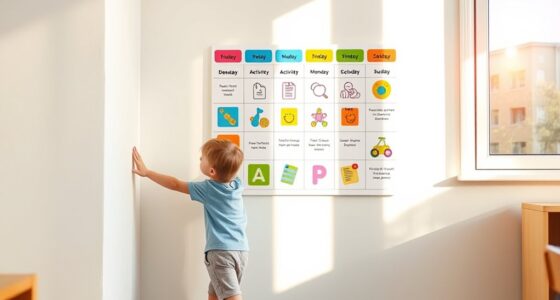To smoothly shift children from play to mealtime, establish consistent routines and use clear signals like words or gestures to indicate the change. Offer gentle warnings beforehand to help kids prepare mentally, and praise their cooperation to reinforce positive behavior. Using a predictable routine reduces anxiety and resistance, making children feel secure and ready for mealtime. If you keep applying these strategies, you’ll discover even more effective ways to promote calm and cooperation during transitions.
Key Takeaways
- Use consistent routines and specific signals to indicate the transition from play to mealtime.
- Provide gentle warnings ahead of time to prepare children mentally for the change.
- Employ positive reinforcement, praising children for smooth and cooperative transitions.
- Incorporate calming cues or gestures to facilitate a seamless shift from play to eating.
- Reinforce routines with positive feedback to promote a sense of security and cooperation.

Switching from play to mealtime can be challenging for both children and caregivers, but a smooth shift sets the tone for a positive eating experience. One effective way to achieve this is by using positive reinforcement. When your child transitions calmly and willingly, praise their behavior with encouraging words or gentle gestures. For example, saying, “Great job putting away your toys and getting ready for lunch,” reinforces their effort and creates a sense of accomplishment. This positive feedback makes children more likely to cooperate during future transitions, helping them associate mealtime with positive experiences rather than conflict or resistance.
Establishing routines plays a vital role in making the change seamless. Children thrive on predictability, so creating a consistent sequence from play to mealtime helps them understand what’s expected. For instance, you might set a specific signal, like ringing a bell or saying a particular phrase, that indicates it’s time to stop playing and start preparing for the meal. Over time, this routine becomes familiar, and your child begins to anticipate the shift, reducing anxiety or resistance. Consistency is key—if you occasionally skip the routine or change the signal, it can create confusion and make future transitions more difficult.
A predictable routine also provides a sense of security. When your child knows what’s coming next, they feel more in control and less overwhelmed. You can enhance this sense of security by giving gentle warnings before transition points, such as saying, “In five minutes, it’s time to clean up and wash hands for lunch.” This helps your child prepare mentally, easing the change and reducing tantrums or protests. Pairing routines with positive reinforcement, like a smile or a gentle pat, reinforces their understanding that following the routine leads to positive outcomes. Incorporating consistent and eco-friendly planters for their space can also subtly reinforce the importance of routine and order in other areas of their life.
Frequently Asked Questions
How Can I Make Transitions Smoother for Sensitive Children?
To make shifts smoother for sensitive children, use visual cues like timers or picture schedules to signal change. Incorporate sensory strategies, such as calming music or gentle touch, to help them feel secure. Give warning before transitions, and use a consistent routine to build familiarity. Stay calm and patient, offering reassurance. These techniques help children feel more in control, easing their anxiety about moving from play to mealtime.
What Are Signs My Child Struggles With Transitioning?
When your child struggles with changes, they often show emotional cues like fussiness or withdrawal, and behavioral indicators such as clinginess or resistance. You might notice they become easily overwhelmed or have difficulty shifting focus. If these signs become frequent, it’s a sign they’re having a tough time moving from one activity to the next. Being attentive helps you spot trouble early and provide gentle reassurance.
Are There Specific Routines That Help With Mealtime Transitions?
Yes, establishing routines with visual cues and consistent timing can make mealtime shifts smoother. You can use picture cards or signs to signal it’s almost time to eat, helping your child anticipate the change. Keep mealtimes consistent every day, so your child learns the pattern. These strategies create a predictable routine, reducing resistance and helping your child feel more secure during the transition from play to mealtime.
How Long Should a Typical Transition Take?
Imagine you’re in a vintage movie—timing strategies and visual cues are your best tools. A typical switch should take around 5-10 minutes, helping your child shift smoothly from play to mealtime. Use visual cues like timers or pictures to signal this change. Keep it consistent, and watch how your child adapts more easily. The key is clarity and calm pacing, making transitions feel natural and less stressful.
What if My Child Refuses to Transition Altogether?
If your child refuses to shift, use behavior management techniques like gentle firmness and patience. Incorporate visual cues, such as picture schedules or timers, to signal the change and help your child understand what’s next. Stay consistent and calm, offering reassurance. Over time, these strategies can reduce refusal and make shifts smoother, helping your child feel more secure and in control during mealtime changes.
Conclusion
As you shift from play to mealtime, remember you’re guiding your child through a smooth progression, like turning the page of a favorite story. Keep the atmosphere calm and positive, helping the change feel natural rather than abrupt. Your gentle guidance creates a bridge, making mealtime feel like a new adventure rather than a sudden stop. With patience and kindness, you’ll help your little one sail smoothly from playtime into the next chapter of their day.










